I’m still quarantining, and I have this whole Saturday yawning before me. This post probably won’t interest many people, but I’m going to write about my Magic: the Gathering decks!
I used to play Magic: the Gathering with a lovely group of people in Minneapolis on a regular basis. About weekly, sometimes more, sometimes less. I played all the way up until I moved away. I miss them, and I miss playing the game.
I have played a few times since moving to Wisconsin. I tried Friday night magic in Lake Geneva. I played with some friends. I even made my game group play once. But I have not found the same appeal that we had with the old group. We played very casually. We didn’t always buy the new cards. We didn’t play by tournament rules or anything. We had ways to accommodate 6 players, 8 players. We would get through several games in a single night. It was magical. I miss them all.
If you are not familiar with MtG, it has five color types:
- Red – a lot of direct damage, very fire-centric, can be very fast
- Blue – very meddlesome, manipulates things on the board, steals
- Green – creature-heavy, can create a lot of mana, provides a decent balance of offense and defense (if I had to take one color to an island I would probably choose green)
- Black – dark creatures, destructive, can cause direct kills to other creatures
- White – life-giving, defensive, not super powerful on offense but can be with a lot of creatures together
- Colorless or artifact – I consider this a 6th group that has established itself as an option in addition to the above colors
Now onto a closer look at my decks*!!
*in no particular order, just literally the order they are in my box
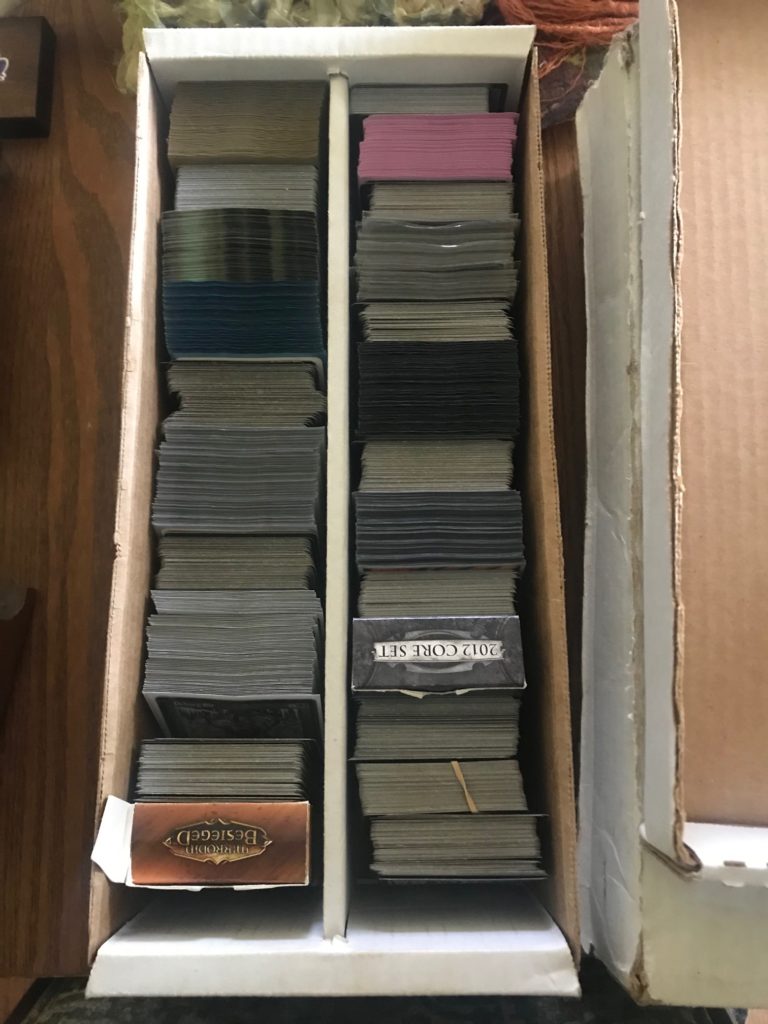
Deck 1 Black and Green Deck
This deck uses the destructive powers of black with the heavy creatures of green and the ability to trample in order to try and overwhelm the enemy quickly. This deck relies on large green creatures that let me deal damage or protect my creatures in an emergency, cards that let me search for the creatures I need, and cards that let me afford creatures quickly.


Deck 2 Red Deck
I don’t love a plain red deck, and it will be clear as we proceed. I didn’t play this one much. But variety is the spice of life. This deck has all the cheap direct damage that is at red’s disposal, some creature cards, and a couple of more rare cards that can give me an additional attack phase and a creature that does severe damage once it is leveled up.



Deck 3 The Gambling Deck (will require a coin on hand to flip, almost constantly)
Oh, not a favorite amongst the group. This deck is red and blue with a number of artifacts to boot. Now you might think I could call this a coin-flipping deck rather than gambling, but there are plenty of cards that just kind of say, let’s level the playing field and see what happens. Very fun. Does not last long because everyone attacks me as soon as they see the coin.




Deck 4 The Soldier Deck
This is a pretty straight-forward soldier deck. It consists of cards that allow me to play soldier tokens, creatures that buff other soldiers, enchantments that improve creatures. It can take awhile to get going, but then it gets fairly tough. The problem is when your group recognizes your deck and knows they have a limited amount of time to keep you in check.

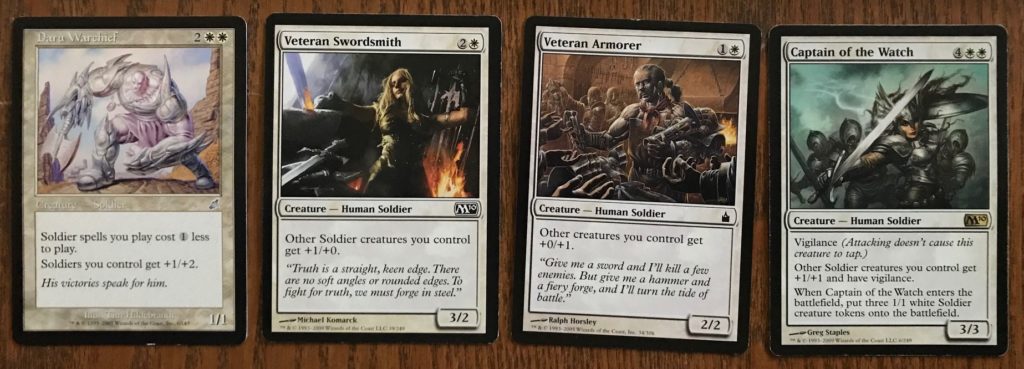

Deck 5 The Decking Deck
If a player is unable to draw as many cards as needed at the beginning of their turn, they lose the game. One way to attack a player is to attack their deck directly by moving cards from their deck to their graveyard. This is called decking. If you think The Gambling Deck is annoying, decking decks are super annoying. This is not a particularly tough one, but it works. I just made it out of cards I had.
Decking decks almost always need team play to pull off a win. They often leave the player completely open to attack and draw a lot of attention.
Be careful about decking vs a black deck. They like having large graveyards.


Deck 6 The Five Color Deck (big creature version)
Five color decks are obviously challenging, plus there are so many different directions to go with one. So go big or go home, I say. This deck has the obvious things that allow me to create different colors of mana, and the rest is huge nasty creatures that I just hope to get on the field.
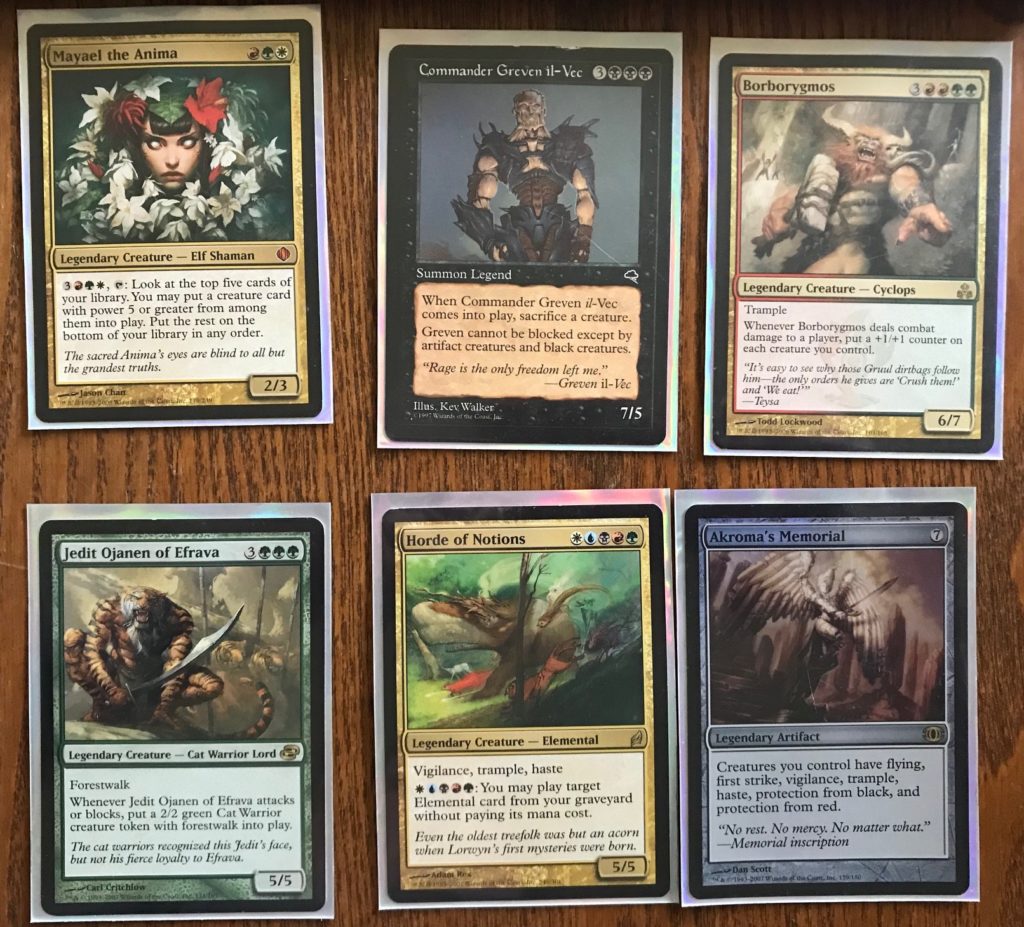

Deck 7 The Leviathan Deck
This is just a blue deck full of large, blue sea creatures. It has a card in it called Quest for Ula’s Temple that gets counters and then lets me put a Kraken, Leviathan, Octopus or Serpent creature into play. I don’t think I built the deck around this card, but I probably chose the creatures based on it since they are all in there. The goal is get big creatures and turn enemy lands into islands so I can islandwalk them into oblivion.

Deck 8 The Five Color Deck (classic version)
Your first draw is so critical in a Five Color Deck. This deck is very diverse and I really enjoy playing it. It does not have a big mechanism that it needs to work. It just has a variety of small, medium, and large cards that play with different colors of mana. It is simple.


Deck 9 The Cascade Deck
Cascade is an ability that lets you play a card and then draw cards until you get a nonland card that was cheaper than the card you played. You play that card for free and put the rest of the cards you drew on the bottom of your library.
This deck is five colors but relies most on red, green, and white. It has cards to increase mana early in the game, and then consists of fairly expensive cards that include Cascade along with creature cards that have haste. It’s a tough deck to get going, but when it works, it works.

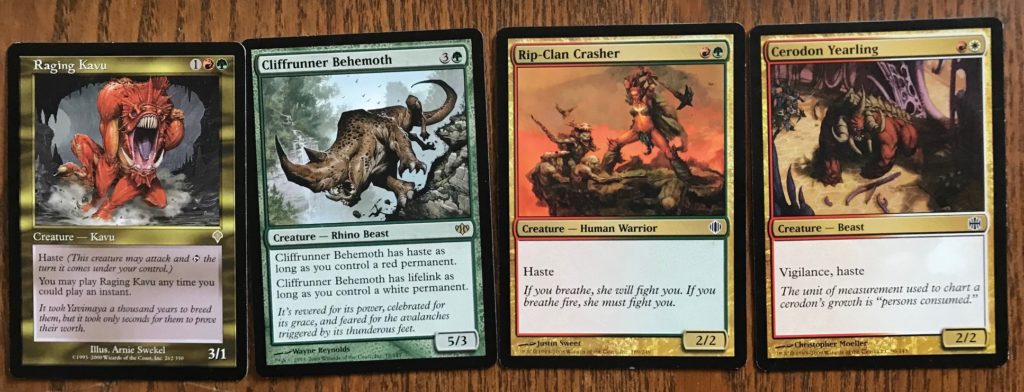
Deck 10 The Polymorph Deck
I love to give my Polymorph Deck a whirl. It consists of just five things: land, cards that increase mana production like Fertile Ground, sorcery and instant cards that generate token creatures, huge expensive creatures that I do not intend to get the mana to play, and polymorph cards.
The Polymorph card allows me to destroy one single creature and reveal cards from my library until I reveal a creature card. That creature goes into play. Mass Polymorph allows me to exile all my creatures (hopefully a ton of tokens) and replace them with creatures from my deck at no cost. There’s no feeling quite like pulling off a devastating Mass Polymorph. You are practically unstoppable then. This is a fun deck.
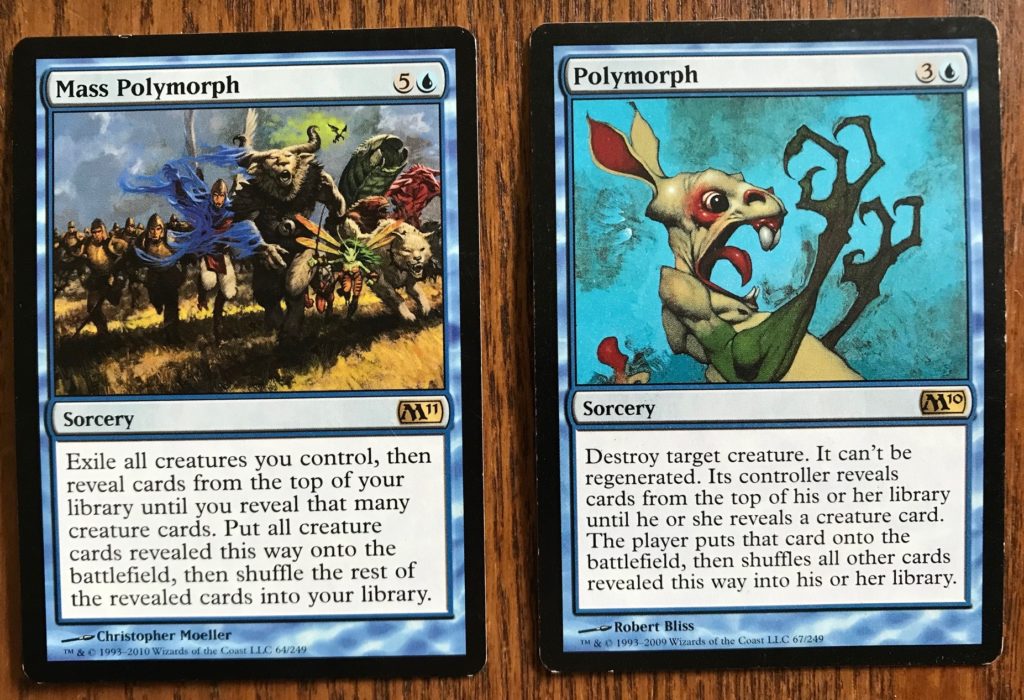

Deck 11 The Tim Deck
The Prodigal Sorcerer card was nicknamed Tim based on the Tim the Enchanter character in Monty Python and the Holy Grail. It includes the ability to tap to deal 1 damage to target creature or player. So our group called that ability Timming. This was my Tim deck. It was feared and revered all over our dining room tables from South Minneapolis to Maplewood.
The deck is red and blue and consists almost entirely of Tim creatures as well as enchantments that let any creature Tim a creature.
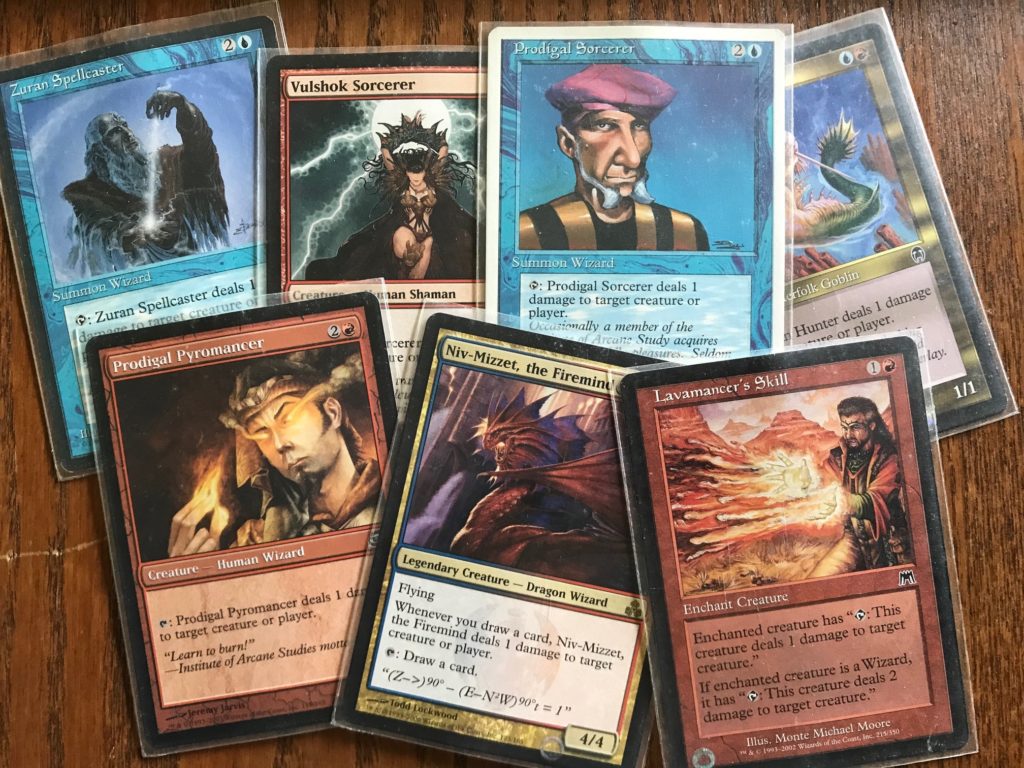
Deck 12 The Artifact Deck
This is a pretty standard Artifact deck that contains several cards with Affinity for Artifact, meaning you pay one less mana for each Artifact you have in play. So it has Artifact Lands, Artifact Creatures, plain old Artifacts. It’s fun, but it’s not my favorite Artifact Deck. I haven’t pulled that one out of the box yet.

Deck 13 The Legendary Creature Deck
As implied by the name, this is a red and green deck that focuses on Legendary Creatures. I’m not sure why. Why not?
To make this deck work, I need lots of cards and lots of mana. So it has Howling Mines to draw extra cards, cards like Wild Growth and Lush Growth to increase mana production, and then a bunch of Legendary Creatures and their supporting cards. It’s similar to a lot of my decks where things have to really come together, but then I get big creatures. There is no shortcut in this, though. I have to pay full price for these Legendary Creatures.
I also only have one of each creature in the deck since playing a second of the same card would destroy the Legendary Creature. I can’t afford to risk having my hand polluted with duplicates.

Deck 14 The White Deck
There is nothing really special about this deck. No particular mechanism. It has cards that protect creatures, cards that grant life, cheap creature cards, and cards that improve those creature cards. This is a deck for a long game. It allows you to be defensive and protect allies, and eventually to make some large attacks and lead your opponents to wonder how they can get past your front lines to get at all the health you stored up.
I like playing white fine, but it’s not my favorite. When I would play the Age of Empires computer game, I would spend what felt like generations of my people in order to set up the best defenses possible before drawing in my enemy. But in MtG I get impatient and want to attack. So this is not a go-to deck for me. It does well in team play though.

Deck 15 The Proliferate Deck
This is another mostly-Artifact deck that is full of cards that add counters (whether they are +1 / +1 or -1 / -1) to creatures and artifacts. Then there are cards that allow me to Proliferate, meaning I can choose where to add counters to improve creatures for myself and my allies or increasingly damage enemy creatures.
This deck contains a lot of cards to increase drawing and mana production.



Deck 16 The Ally Deck
Lots of people have Ally decks because the Ally cards lend themselves to working together beautifully. Mine is five colored. Anyone who plays against an Ally deck knows that it has to be handled, and quickly. Many a time have I sat back and listened while my enemies decide how to triage the damage I am doing to them. The cards are cheap, so unless my mana shuts down with unlucky draws it’s a solid deck. My one kindness with it is to have the deck in card sleeves so the keen observer knows what deck I am playing immediately.

Deck 17 The Spirit and Arcane Deck
I threw this together when we ended up with a bunch of cards that are Spirit and Arcane. This deck is green and white. It is filled with Spirit creatures and Arcane spells, along with cards that make these spells cheaper. It’s okay. I kind of think of it as a poorer version of an Ally deck.

Deck 18 The Blue and White Mess with Everyone Deck
This is a fun deck to play and looking through it really made me want to play again. This deck is full of classic white life-giving and damage-negating cards, along with blue cards that manipulate what is in play. One of the beautiful cards in it, too, is Leyline of Anticipation which you can play instantly if it is in your opening hand, and it allows you to play nonland cards as though they are instants. That allows me to keep my mana handy to play interruption cards or, if nothing comes up, to play a creature card at end of turn of the player before me.
This is particularly a great deck for team play because I am unsummoning, countering, gathering life, preventing damage, causing opponents to pay more for their spells, all kinds of mean things.
I particularly enjoy the passive defense in this deck. I’m wide open, and you can attack me. But it’s probably going to hurt you more than it hurts me.

Deck 19 The Best Artifact Deck Ever
I love this deck. I don’t always play it because the play can take a long time. It involves tons of adjusting and playing and pulling back and reshuffling. Some turns I draw like 15 cards. It can get old for my fellow players, and I appreciate that.
This is a Blue Artifact deck. The goal is to get tons of mana and endless artifacts in play. Artifacts can give me no max hand size, cause opponents to lose life when they play creatures, give their creatures negative counters, etc.
One key component of this deck is the card Elixir of Immortality. True to its name, this card not only gives me life but allows me to shuffle my graveyard into my library. I can play this deck almost eternally. It’s tough to beat but the offense isn’t great, so I have to really focus on doing what I can to destroy my enemies. Otherwise this deck just wears them down, which isn’t fun.
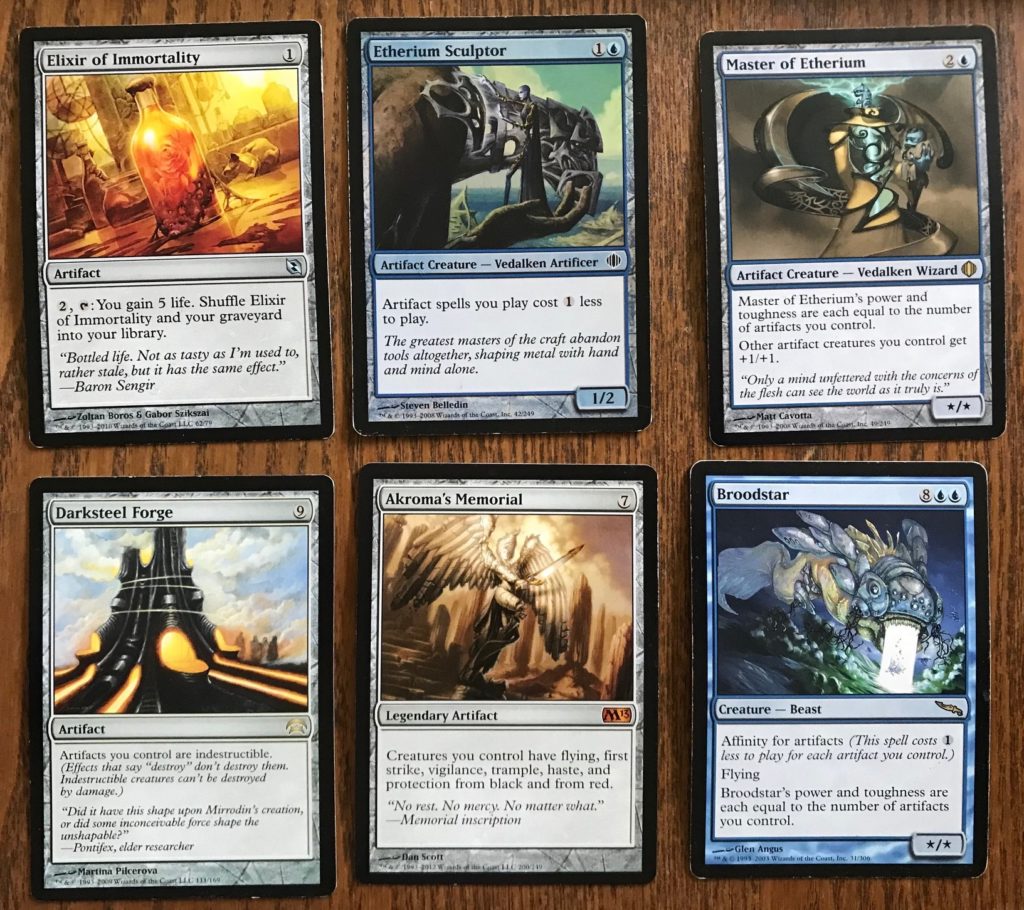
Deck 20 The Direct Damage Deck
This deck is the only one in this list that I did not make. It belonged to my good friend Peter, and I admired it and feared it for a long time. He gave it to me one game night, probably for my birthday or some such occasion.
This is a green and red deck, and it’s a thing of beauty. Its focus is in creating incredible mana output. All of the land is Forest, and so there are Wild Growths and Fertile Grounds. Then there is a key card: Utopia Sprawl. When that comes into play you choose red since this is the only way to get red mana in the deck.
The rest of the deck is Creatures like Overgrown Battlement that give you a little defense, but also can be tapped to add more mana to your pool. The rest of the creatures simply allow you to untap a land. The idea is simple: get a few Forests out there that are stacked with extra mana cards that you can untap to create a huge amount of mana in your pool. Then play a comet storm and rain fire on your terrible friends. Comet storms allow you to switch targets and you can choose between creatures and players. This can be incredibly destructive.

Deck 21 The Elf Deck
I couldn’t find the exact rule, but I’m pretty sure there’s a rule that everyone must have an Elf Deck. Mine is my very first deck. I probably don’t need to explain an Elf Deck to you… it is full of elves.
This is a tough deck. Elf Decks start deceptively small, but they can get tough very quickly. My deck relies a lot on Blanchwood Armor to do really heavy damage. Ideally I can enchant a Silhana Ledgewalker so my enemies can’t really do anything about it. It’s my oldest deck, but I still enjoy it.

Deck 22 The Equipment Deck
I made an Equipment Deck. It’s not my favorite; equipment in general is not something I have patience for. The deck is okay.
This deck includes white creatures, a few that have particular powers related to equipment. Then there is just equipment galore! When you pack enough equipment onto a single creature it can get really tough, providing both offense and defense. It just takes awhile to get there.


Deck 23 The Bird Deck
Last but certainly not least is my black and white bird deck. I did make this deck around a single card: Soulcatchers’ Aerie. This card allows me to put a +1 / +1 counter on it whenever a bird goes to my graveyard from play, and all my birds get that counter. So I can have up to four Soulcatchers’ Aerie cards played if I am lucky enough to draw them all. So I am not opposed to my own birds dying. I got more where they came from.
This becomes annoying for my fellow players. Sometimes they are not obliging enough to kill my birds for me and I have to do it myself. That’s where black comes in. I have four Carrion Feeder creatures that allow me to sacrifice a creature to put a +1 / +1 counter on the Carrion Feeder. But that sacrificed creature will be a bird so I get the counter on the Aeries too.
This deck can be pretty tough. The beauty of it is that birds are cheap, and even if my mechanism does not come together or gets handled, an army of flying birds is not the worst thing.


That’s it!
That’s all my decks. The casualness of our play comes out in these descriptions. Creating MtG decks is game design with pre-defined options. While it’s not my style, I know and admire people that do MtG deck design with the strictest disciplines that MtG communities offer.
No matter where you fall on that spectrum of seriousness, if you played much at all you likely have some favorite decks and fond memories. I’d love to hear them. 🙂